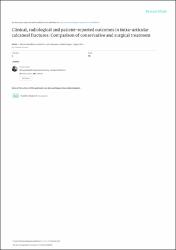Clinical, radiological and patient-reported outcomes in intra-articular calcaneal fractures: Comparison of conservative and surgical treatment
Abstract
Objectives: This study aims to compare the radiological, clinical and patient-reported outcomes of patients with intra-articular calcaneus fractures treated conservatively or surgically. Patients and methods: Fifty-four patients (30 males, 24 females; mean age 41.0 years; range, 18 to 73 years) treated due to calcaneus fracture were included in the study. Twenty-nine patients underwent conservative treatment (group 1) and 25 patients underwent surgical treatment (group 2). The fractures were classified according to Sanders. At the final follow-up, patients' Bohler's angle, The American Orthopedic Foot and Ankle Society (AOFAS) Ankle-Hindfoot Score and Foot Function Index (FFI) were used to evaluate their radiological, clinical and patient-reported outcomes. Postoperative complications were also noted. Results: The fracture was at the right foot in 28 patients and the left foot in 26 patients. The mean follow-up duration was 41.1±23.2 months (range, 24 to 126 months). No statistically significant differences were found between the groups in terms of gender, fracture side, mean age, or follow-up duration (p=0.951, p=0.571, p=0.326, and p=0.620, respectively). According to Sanders classification, 18 patients were type 2 and 11 patients were type 3 in group 1, while 11 patients were type 2 and 14 patients were type 3 in group 2. However, there was no statistically significant difference between the groups in terms of the type of the fracture (p=0.184). On the other hand, the outcomes were significantly better for group 2 compared to group 1 in terms of the Bohler's angle, AOFAS and FFI scores (p=0.004, p=0.003 and p=0.006, respectively). In group 1, subtalar arthritis developed in three patients. In group 2, wound healing problems and superficial infection developed in three patients, while subtalar arthritis developed in two patients. Conclusion: Surgical treatment is more effective in intra-articular calcaneus fractures compared to conservative treatment according to clinical, radiological and patient-reported outcomes. In addition, wound problems should be considered in surgical management. © 2019 Turkish Joint Diseases Foundation.
















